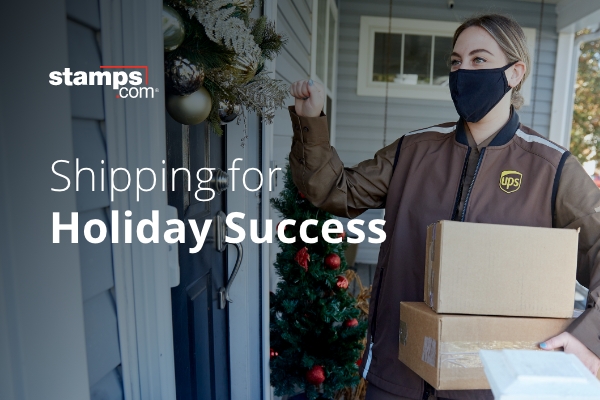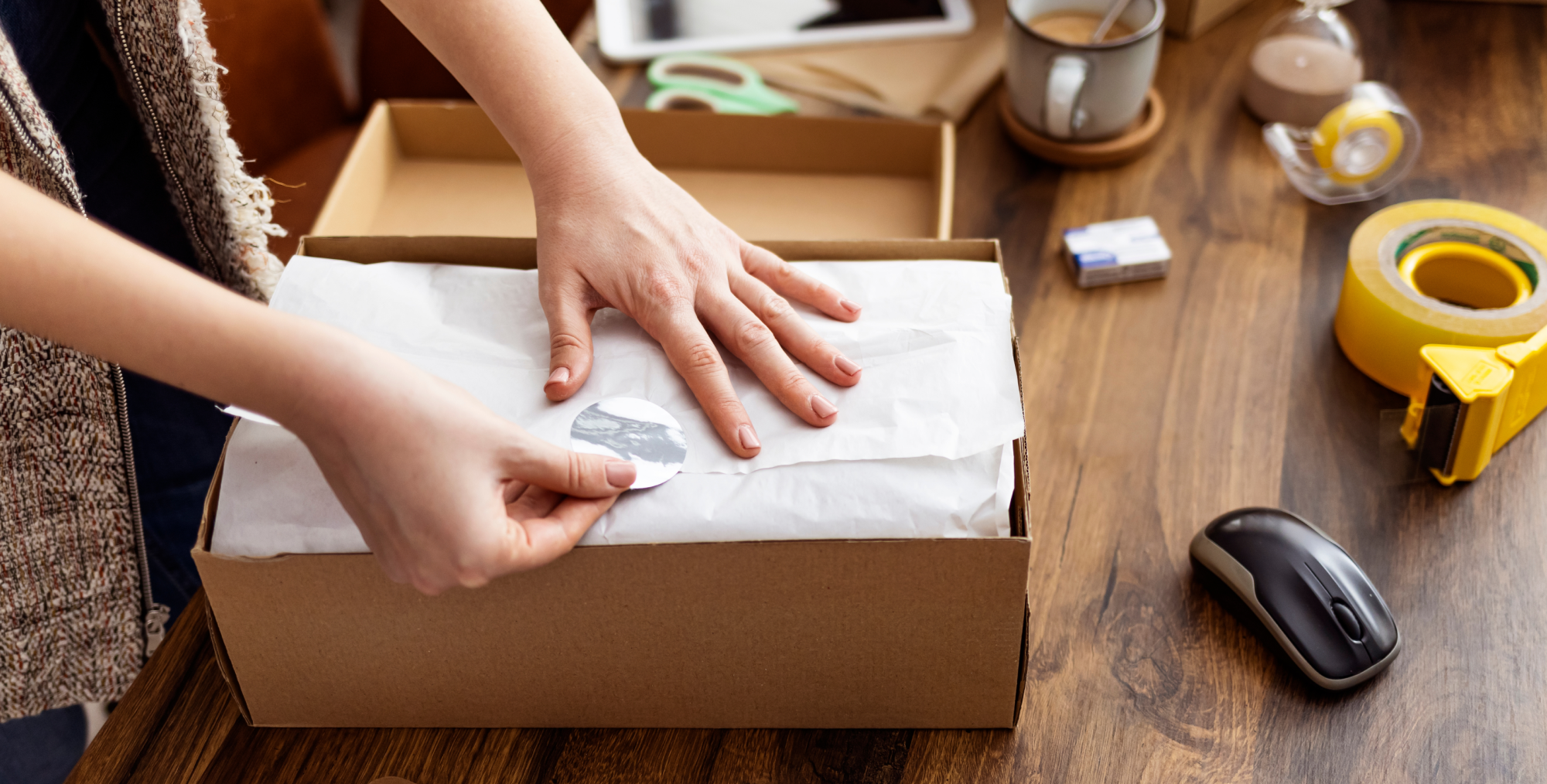Stamps.com hosted a webinar titled Social Marketing for Small Business on November 17, 2010. (Click Here to view the recorded webinar.) The presenter was John “ColderIce” Lawson from ColderIce.com. The topic was developing a social marketing plan for the small business owner. Here is the transcript from the webinar:


Eric Nash from Stamps.com: Hello everyone. I want to thank you all for joining us today and I welcome you all to the Stamps.com webinar series. My name is Eric Nash, and I’m the director of online marketing here at Stamps.com.
Today’s topic is Social Marketing for Small Business and we’re really excited to have e-commerce and social media expert John “ColderIce” Lawson present today. John is the founder of the industry famous E-commerce blog ColderICE.com and he’s also the CEO of 3rd Power Outlet Inc. John’s a certified eBay platform Powerseller with more than 100,000 transactions. On the social media front, his videos have 135,000+ views on YouTube and he has over 35,000 followers on Twitter. He’s been featured in The Wall Street Journal, The Washington Post and PC World and he’s even had his business featured in an American Express commercial.
Okay, before I hand the controls over to John, I want to do a quick poll to see how everyone is selling their products or services.
How do you sell your products or services?
- E-commerce / Web-based (Online Only)
- Both Online and Offline
- Brick and Mortar / Retail Location (Offline Only)
At the end of John’s presentation today, we’ll have some time for questions and answers. If you have a question for John, please use the question box in the window on the right side of your screen. That’s how we’ll filter all the questions and get them over to John at the end of the presentation.
Okay, without further adieu, let’s hand the controls over to John “ColderIce” Lawson. John, take it away.
John “ColderIce” Lawson: Okay guys, I think we are ready to rock n roll. Thank you for the intro and you know, let’s get down into this thing.
Alright, and I’m just gonna kind of go a little bit quick here. I’ve got a lot of stuff to cover and I want to make sure you guys get all of this information. Hopefully you’ll walk away with some really actionable stuff after we get done with this hour, okay?
So I want to review who I am. I’m just John but what I’ve done over the last couple of years was start a blog. I started a blog and I actually won an award in a StartupNation contest for being a social savvy kind of guy. So, I’m social savvy now, at least in their eyes (laugh). So, that was the award the blog actually garnered for me. But I’m also a top E-commerce seller and I sell in EBay, I’ve got over 108,000 feedback from buyers. That’s actual transactions that we’ve done with customers that have left a comment. I’m also a top seller on Amazon’s platform and I have my own web store, of course.
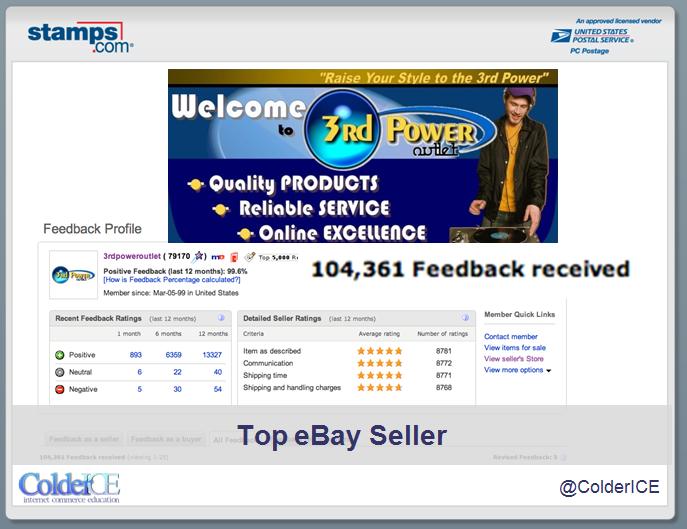
So, let’s just get into this, what is the world wide web? Or what is the world wide web becoming? The web is really becoming people being able to get what they want, when they want it and the way that they want to buy it. And the more we move into the future, the more of this becomes reality. So, we know that the world wide web is gynormous, it’s huge! And you have to keep in mind that this is me, I’m the needle in the haystack. And to try to get yourself, your products, your business noticed, you have to come from the life perspective of, “Hey, that’s me, this is how big the stack is, and I’m just a needle.” So we want to use some tools to help us move so that we can make more impact in our area of expertise or whatever it is that we are selling, whatever that might be.
So, in order to start, I want you to really open your mind up because you could explore some new ideas, there’s gonna be some new opportunities that you might discover. I’m gonna give you some facts that I have actually, you know, glean from my years of doing E-commerce. And you know, some of it might be a little uncomfortable advice for some of things I say because I am not your average everyday wannabe guru. I’m not wanting to be anything, I’m actually doing what I talk about. This is about making money and showing return on investment because I’m running a business, my business has to make money or my children don’t eat. So, I’m gonna not going to spin your head with surreal info. We’re going to talk real hard facts. So this is just one-man story, it’s my story, OK?
First, let’s talk about the walls on the web. You know, we used to have a sort of prison theory back in the early part of E-commerce. Where if we can get somebody to our website, all of a sudden, they would be totally entombed, and they would stay on our web page forever. Well, that’s not the case anymore. The prisoners have been released and you can’t really say that somebody’s dropping into your website and they’re going to stay there. Or that they will find the information for the product prior to purchase by going to your website. A lot of times, people are already finding the information and already decided to buy prior to even entering your website. So that kind of philosophy is, a little bit old and the walls have now come tumbling down.
What’s going on in terms of web and technology really? And if you look at this slide right now on the left hand side, you will remember that thing at the bottom, that personal computer, you know if you’re old enough, you remember you had like one color in the screen, we had black or green. You know, maybe some blue if you had, you know, one of those. But you had a monitor and in order to make entry, your input device was simply a keyboard. And if you have to go to the next field, you would use the tab key, you know. And we were creating on that device right on it. It would actually reside on that personal computer and if we wanted to share what we had on that device, we’d actually have to copy it to a floppy disk drive or a CD back in the day and move it over to another computer just to share it with somebody else. Then we got into the next page of evolution here and we got a mouse. So the mouse was kind of cool because you could interact and you didn’t have to tab, tab, tab, tab, tab. You could just click to get to that point where you want to go. We have this nice view, your graphical interface. And communication started moving forward with things like email. So, instead of creating something directly on a PC, we could actually create it and then share it with somebody, the email, they would then open that file and use it. So that became like internet communication or internet computing because now our computers work semi-tied together.
So fast-forward to today and look at the innovation that we have. We input things with our fingers now. You could touch the screen, you could make it larger, you could make it smaller. There’s a keyboard on there, you click the key and we’re not just sharing the information but we’re actually able to consume the information and then share it again. I like to use the example of consumption where we’re being, let’s say, you create a playlist for your iPod. You can actually share that with somebody else and they can consume that same playlist that you have and then share it with somebody else. So now, we’re not just sending things to each other, we’re actually able to consume it, revive it and we push it back up to other people that are on that network. And of course, we’re no longer just attached to our desktop, nor just to a laptop. A lot of this way we’re able to do in our pocket, with our mobile phones and mobile internet communications. It’s absolutely amazing, the evolution we’ve gone through in this short period of time of maybe about 30 years when it comes to personal computing. How has that changed everything? Well, it definitely has changed everything.
It’s a new web experience today. It’s very personalized. Unique results are being sent to you even in Google. When you log in to Google, what you see when you search is not necessarily what I will see when I search. And right now, I’m not at my home location, I’m away and when I do a search for a restaurant, it recognizes what zip code I’m in and brings back a lot of location based results. So, it’s very personalized. And also, it’s becoming where it’s more socialized because all of the things that you get, you can share with other people and those people keep consuming. I can tell people about what restaurant I just ate at and give some star reviews and posted out on multiple sites and people can say, “Oh, okay, well, John recommended that restaurant.” And they’re able to now consume it and I’m able to push it out in the social media space and of course, it’s mobilized. This guy loves his phone so much, he attached it to his head. You know, or you can see one of those people that are running around looking like the lady from Star Trek with that thing blinking in your ears, I’m not a fan. But it’s mobilized now, so every time I am using my phone, I can actually say, “Well, here’s where I’m at, where’s a good restaurant?”, and it will give me a restaurant right near where I am standing. And you know, it’ll tell me how many blocks I have to walk or how many miles I have to drive and it’ll give me that experience through applications. That’s where we are today. So, if you want to be successful in this new environment we call social media, mobilized commerce, and all of that kind of good stuff. Here’s what I suggest you do, and this is what I do. I’d study the 1% of success, that’s the people I want to watch. I want to watch the people out of the biggest, the baddest and the best out there. I don’t go to my buddy and ask him about how to actually do well in social commerce. You know, because this is not necessarily doing much more than I am doing, you know. There could be some people that are little bit larger. But I want the top 1% and I wanna study what they are doing and then back it down. You know, bring it down to my level and see how I can implement that for my business.
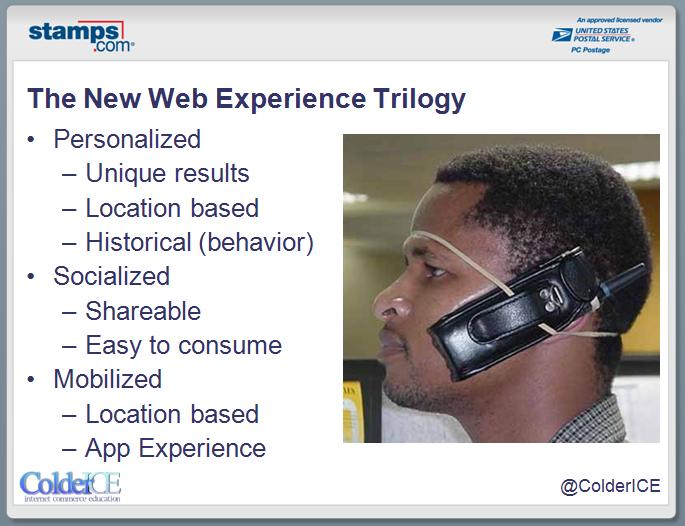
So, let’s go to one of these one percenters. How many of you heard of about the Dell PC Twitter case study. Dell PC says they made six and a half million dollars on Twitter. Six and a half million dollars in sales on Twitter, it was carried by most of the financial channels. It was carried by pretty much every Twitter personality I’ve ever seen. It made a lot of noise. So, they sold six and a half million on Twitter through a worldwide audience and a worldwide reach. Wow! Six and a half million dollars! That’s a lot of money! However, I was interested in knowing what did that six and a half million actually represent. I mean, if I say six and a half million to somebody like you and I, small business owners, we say wow, that’s a lot of money! Alright? But you know, is it to Dell? Well, I grabbed the 10-K Form, which is a public company form that Dell has to report. 2009 net revenue for Dell was 52 billion dollars! 52 billion dollars is a lot of money. And when you compare 52 billion to six and a half million, you kind of see the real perspective of how much of that business was done on Twitter or a company that is a 52 billion dollar company.
Here’s my pie chart, this is the pie chart of social media’s contribution to Dell’s actual gross profits. It’s a little bit hard to see. So, let me expand this just a little bit so you can see it, okay? That is about how much that six and a half million from Twitter absolutely represents. So you have to understand that perspective is always important. So if I just tell you Dell did X, what I tell you but they do Y. Then X was a lot bigger but it’s not as big as I thought. However, you know, if you really break it down for every $10,000 that Dell brought in, $1 of that came from social media. Well, are you really saying that they hit the lottery there? Excuse me, I don’t think I’m really gonna spend a lot of time trying to make $10,000 in one of those dollars comes from social media. That doesn’t sound like some big ROI that I’m gonna be all that excited about. That didn’t hit the lottery there. However, they did hit the lottery in media coverage because the amount of influence that story generated has been priceless. So, I mean, it did pay off for them, at least in the media coverage perspective. The media coverage was absolutely priceless. Dell couldn’t buy that much media coverage even if they wanted.
So, I’m taking all these new social media issues into account and understanding how important they are. And I was looking at some of the others things that are going on in high tech such as mobile phones and location-based tagging.
I figured it was time for my company to really grow up. And if you look at this chart, on the left hand side going up is Differentiation. How different you are from the competition and then going across on the bottom horizontally, that is Industry Adoption. And if you look at the first smaller circle, it’s the Baseline. That’s the features that most people are doing. That’s what everybody’s doing. Then if you move up a little bit, you have strategy. Some people are strategic, they’re a little bit above the curve in terms of things that they’re doing today that other people might not do for another six to twelve months. But we want to get into the Visionary section. That was the thing I want to get to, concepts that are experimental and things that are not everybody is doing yet so that it would give me a huge amount of forward motion that my other competitors could not keep up with. And with this new economy, and the way things are going right now, you want to take every opportunity to actually grow your business in these times where everybody else is trying to shrink.
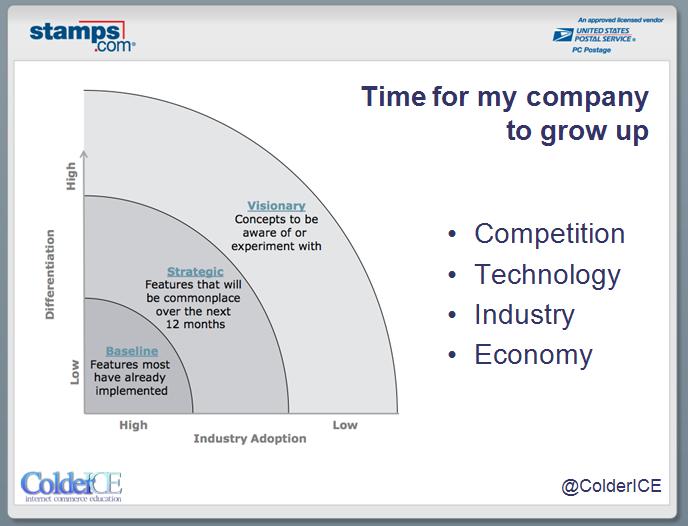
So, here comes my system at 30,000 feet. You have Goals and those Goals should lead to the Content and the Content that we create leads to the Infrastructure so it maximizes our Operations to achieve our Results and meet our Goals. And we’re constantly in running these through this actual system. So what are some goals that you can have in social media? You can have Conversion, Order Size. SEO, of course. You wanna have the best match for search engine optimization, your products should show up, we want them to show up as high as possible. Efficiency, if you can use social media to make certain areas of your business more efficient especially in customer service and user-generated content. You can use that for Branding.
Some of the content that we can use: editorial content, which of course are descriptions from your products, user generated content which will be feedback, customer concerns, actually dealing with forums, product data and again branding, another good one in the content area.
Infrastructure you can actually use. This is kind of different, but you can actually store a lot of information on this free platform, okay. Sometimes picture storage on Flickr is not where you actually wanna store everything that you’re really actually using. I would use them for the backup but having some of your pictures on Flickr with the proper tags can actually drive traffic to your store. So, we’ll talk about, you know some of those kinds of techniques.
Management, collaboration, syndication, syndication is very big. I’m speaking into a microphone right now. I can save that file and have it transcribed and syndicate that text out in both voice and through blog post or stories, things like that. Syndication and localization. The operations portion, scalability and extensibility. And that is one big thing that is going on with a lot of the social tools. And that they are scaling rapidly and as they scale rapidly and as you become more aware of what the opportunities are, you will, you know, scale as well because the tide lifts all boats.
From the results that you wanna measure, ROI of course, globalization, cost-efficiency, product data, leverage in that data, okay. So, what you want to do is use technology to help you make your life simple. Use the technologies of today to help simplify your business, automate some parts of your business and then once you find something that’s working well, use it to duplicate it. So the question is if I find something that’s actually working for one of my products, can I duplicate that throughout my entire product line? Absolutely, and you can do that very easily with the technology available to us today.
So, why is social media so important? Well, hey, social media is a low cost solution and extremely high-end technology. This kind of technology would have cost you, tens of thousands of dollars. Just five years ago, it would have cost you thousands of dollars to have a good community blog site. Today, you actually can get it for little or no cost using tools like a Facebook, you know, a Fan page. Understand that social marketing is not a religion. It’s not a, “let me come to the altar and pray and hope and wish that something will change.” It’s not that kind of party, don’t let anybody get you twisted in thinking that. You need actual results. that there are no results that you cannot measure how well it is working or if it is working. And I hear so many so-called social media people that will tell you all these things and you ask them, “Well, how do I measure the results?”, and they will start giving you their religion. I don’t want your religion, I need profitable results, okay? Understand this guys…everybody talks about Twitter, they talk about Facebook, LinkedIn, and more Twitter and Facebook. However, there are over 1,600 social sites and that’s just in English. So when we talk about social media, do not limit yourself to just two or three sites in thinking about the scope and how you are going to attack this opportunity.
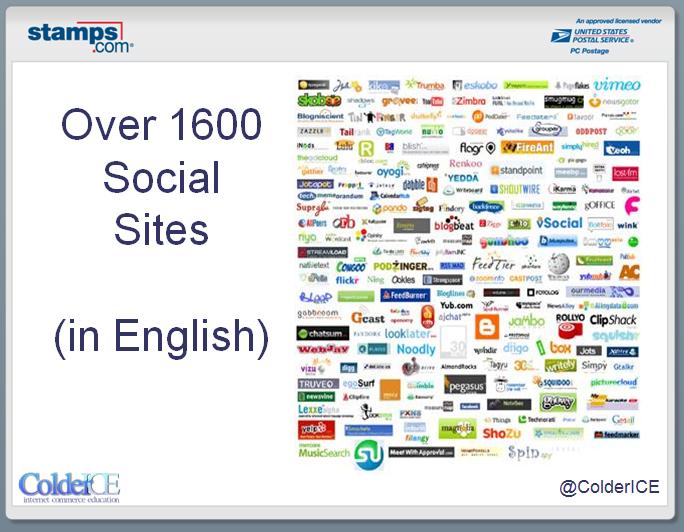
So, here’s what I’ve done. This is what I’m gonna share with you. I’ve done a lot of research. Over the years, I tested a whole lot of sites, honestly. And I’m gonna bring my objective research to you. I mean, I’ve got some actual data from hundred of tests that we’ve done. I’ve tested hundreds of applications, so I’m at least giving you an educated opinion, not just something somebody told me, this is actually the real deal, alright. So, are you ready? You’ve got to be ready for this ‘cause now it’s gonna get a little bit uncomfortable.
Here’s your typical sales funnel that everybody is familiar with. So, what is changing in today’s business application with social media? Well, here’s the deal. If you go into this chart right at the top of the funnel, it was very wide. You could use traditional media like TV, print, radio, outdoor advertising and you can get huge amount of awareness of your product. That awareness was translated to interest when people then began considering making that purchase, you wanted your items to be the preferred, location for that purchase, or your entity to be preferred, location. So the top part of the funnel was very large but the bottom part of the funnel was extremely hard to do. I mean, you couldn’t really do all the purchase upsell that you could do online. You couldn’t do all the cross-selling, you couldn’t do the loyalty branding. It was hard to do that, it was very, very costly.
What has happened now is that the top of the funnel is shrinking because now I don’t have ABC, NBC and CBS, I’ve got 800 channels to watch. So running a TV ad doesn’t give me the same kind of awareness that it might have in the old media way, right. So, traditional media like print and radio, people aren’t doing those kind of things anymore. They are not listening to the radio. I’ve got all my music on my iPod. I’m not reading the newspaper, I’m visiting websites. So, I’ve got my RSS feed. So, that funnel has gotten a lot more shrunken.
But with new media, and I don’t really wanna call it new ‘cause it’s not that all new but with multi-channel and direct marketing, we now have a huge bottom end of the funnel. So, when somebody comes to our website, we’ve got tools now to upsell them, to cross-sell them and to get some brand loyalty to bring them back. These tools, which were so costly in the early part, are now free in social media. And it’s really exciting, it’s turning things upside down and you have got to get into this so that you can increase your bottom line. That’s the benefit to us as actual e-commerce and just plain retailers in general, okay. What it is allowing you to do is some form of social espionage. It’s like, “I know what you’re doing and I know when you’re doing it.” It’s actually real-time data that you can use. You can find out what people are talking about, what are their key conversations, when they’re having it, where are they having this conversation, where it’s happening? And who was actually doing the talking? Are they influential people? Are they just regular customers? Are they angry? Who is doing it and why are they doing it? Is it positive or is it negative? You can discover why conversations are happening right now with social intelligence.
And also, you have a vehicle now for communication and you can actually see inside of that vehicle for who they’re talking to. You can actually call back to them, keep them ‘in the know’, and spark a conversation with your customer-based or with your influencers or with your brand advocate. It’s very important. The whole world is talking. If nothing else guys, listen, I’m not saying you have to get engaged. If you get nothing else from this webinar, learn how to listen. Okay. Because the customers are talking about you, your products and what they want.
When it comes to social media, I’m gonna tell you, it doesn’t have to be complex. If you keep it simple and spectacular, you’re gonna do well. And that’s what you want to focus in on. How can I make it very simple so I can get the results? So let’s focus in on the tools that will help you do that.
Customer Analytics. The more you know, the more you sell. So, let’s find out how we can learn more about our customers. One of them of course is getting feedback from the customer. It’s very important that you get feedback and you ask them to give you some feedbacks so you know where you are. Here’s the tool called Kampyle. Kampyle will put a simple question out there or you put a question out there on with the little spaces and people will respond and they will make suggestions, alright? That is a free tool you can use, it’s a Kampyle. You notice the spelling, K-A-M-P-Y-L-E.com. Excellent tool for getting customer’s feedback.
Next one is called Rapportive, okay? Notice the spelling again, rap-por-tive, okay? And what that does, if you have a Gmail account, this works for Gmail. Then when somebody writes to you in Gmail, it will go out there and crawl the social space for any information that is available freely and openly from that person, if they got a Twitter account that’s attached to that email, if they got Facebook post that’s attached to that. You will get that if they’re on Linkedin, if they’re on Twitter. It goes through hundred of sites looking for that profile from that person based on that email address. Fantastic to use when you are dealing with customer interaction, you’re actually finding out where they reside.
The next is Twitter, and this is a tool for Twitter. It’s called HootSuite. Again, notice the spelling H-o-o-t-s-u-i-t-e.com. Hootsuite allows you to track your Twitter friend. So of course, you can organize your Twitter friend, maybe you want your family, your business, you know, your vendors and you can put them in different columns on Twitter so you’re not looking at one long list. But that’s cool. And the other thing that it allows you to do is it allows you to get statistics on URL that you embed inside of your Twitter post. This kind of an analytics tool is really fantastic. You can actually see how many people clicked on that link, when they clicked on that link, and what country they’re from. I mean, it’s absolutely incredible and it’s a free tool, it’s a free tool. So that’s another one of those tools where you could actually find out ‘cause the more you know, the more you sell.
Now, here’s one called TubeMogal. This is what you would use if you’re deploying videos, okay? When you wanna deploy a video, instead of just putting in on YouTube, you put it through TubeMogal, again notice the spelling, T-U-B-E-M-O-G-A-L.com. It’s a free tool and what that will allow you to do is upload it. Once the video file is uploaded to TubeMogal, the video will get pushed out to 16 different sites. Fantastic tool. Let me go back and just show you again. It’s TubeMogal, alright?
Now, this is my webpage. This is a landing page for one of our products. And if you’ll notice on the bottom corner here, right there, there is a little share tool. And it allows people to share that product with other people either via email or Facebook, Twitter, things like that. You can get this tool, it’s absolutely free, it’s called Add This. And that’s A-D-D T-H-I-S. There’s different buttons — if you look at that under number 2 which is “Select a button style.” A lot of people use that default what I had with the third one down, you know. And you get your button, you put it inside of your webpage or inside of your blog and it allows people to easily share your information.
Another one is SurveyMonkey. This allows you to create surveys that you send out to your customers. It is amazing, if you have never sent a survey out to your customers, it’s amazing what customers will tell you. They love to hear that you’re interested in hearing from them. They want to know that you care. And when you send the survey out now, “Hey, how was your service?” They’re like, “Hey, you know what, these guys care”, even when it is a bad situation. Now you’ve given them a vehicle for them to communicate back to you where you can make a change, you can fix that problem and you can turn somebody that was not happy into an advocate. My best advocates are the ones that had a bad experience that I made right. They become the best advocates.
Facebook. I know everybody’s on Facebook. How many of you guys have been to this page? Facebook.com/facebook-widgets. I know, it’s a long URL and it’s probably that way just so everybody doesn’t get it, alright. So just the fact that you visited this page will put you way ahead of everybody else in the game, trying to do Facebook. Check it out, Facebook.com/facebook-widget. This is how you get the little share button in the upper right or left hand corner that you see on people’s blogs, just so you’ll get some fan boxes, badges, all of those kinds of things. There’s a lot of widgets that a lot of people don’t even use ‘cause they’d never visited this site. They don’t even know about it. And just because you came here, you got a good tool that’s gonna get you above the fray on Facebook.
Okay, the other one is, often overlooked, it’s called SlideShare.com. The reason why I like SlideShare is because maybe you don’t wanna make a video. Maybe you’re not comfortable doing some audio or podcasting thing. But everyone of us are already comfortable with making a slide presentation. You can actually turn some products into slides, put them on SlideShare and share them with the world. And what that’s gonna allow you to do is give you some SEO bump towards your product category. Now, you want to make sure you don’t just take some pictures of furniture and you’d put that junk out there. You want to actually offer some good quality information around your product. So, maybe if you’re selling furniture, you’re telling them how to clean furniture and you’re showing pictures of other items that you sell on the same page. You are saying “Hey, we actually do sell this kind of furniture. We sell this polish too.” But you need to offer good quality content that would make somebody not only just watch the presentation but actually share with somebody else and at the same time, you’re gonna get the SEO bump because SlideShare is ranked really pretty high in Google ranking. So that’s more SEO bump for you and your site.
Let’s talk about blogging real quick, okay. Because I am a proponent of blogging. You have to blog! Do you have to blog like everybody else tells you to blog and do it all day long, the answer is no. But if you do nothing else, get a blog site and put your ten most asked questions on that site and answer them. Use your ten frequently asked questions. That alone will give you SEO bump and it’ll also get you started in getting the feel on blogging. Because we all know that your customers want them because they ask ten frequently anyway. Look, Google loves blogs, almost instantaneously these days. It will start ranking your blog posts very quickly. As a matter of fact, it became so imperative that Google ranks blog that they created a new index page tool called Caffeine where they would scrape blogs and sites quicker. But really most of the things that were changing for Google were blogs. And they had to get that information index faster than they were previously. So now, they are able to get new blog posts indexed very, very quickly because of Caffeine, and blogs rank very highly. You know why Google ranks blog high? Because they recognize that if a post title says XYZ, then most likely the content will actually be XYZ. So, they realize and recognize that blog site actually has good quality content that people are looking for. And that’s why I believe a blog is something that you have to do if you want to get started in social media. I would absolutely suggest before you Tweet on Twitter, before you make a Fan page on Facebook, before you get a LinkedIn page, all of these other things, I would actually say the most important thing that you could do for your business is start a blog. And it doesn’t have to be something that you do every day, every week, not even every month. It’s just something that you need to do as soon as you possibly can do it. That’s my personal opinion.
So, the other thing that Google loves are videos. If you did not know this, the number one search engine site is Google.com. The number two search engine site is YouTube.com. YouTube is the second largest search site. After somebody searches for something on Google, they’ll most likely to search for it on YouTube. They love it, I love it too. Here’s a video I created back in 2007. I was not real pretty, I didn’t even believe that anybody would care. If you can actually see this on your screen, it has very poor quality, it’s incredible how bad this video is. But I sell bandanas as you saw in that last slide. And people kept asking me, how do you fold the bandana, to look like Tupak. I don’t know if you know Tupak, he’s a rapper. You know, he died years ago. I mean, what, in 90’s? Some people still see pictures of him with his bandana, you know he had a pretty unique way of tying it. So I decided to create a video that showed different ways to tie a bandana, alright. And I put this video on YouTube and right now, it got over a 140,000 plus views. And if you notice, at the top there is a red button “Get Bandanas HERE, 3rd Power Outlet”. The YouTube video has my branding, alright. And if you look down below the video, it’s got my URL and it’s clickable. So, everybody that’s looking for how to tie or fold the bandana, can also find where to buy bandanas. And we have tracked over 10,000 actual sales from this video alone. One video and if you go out there right now, I think it has over 140,000 views. It’s constantly moving and If you look at that last part where that little green hill is. That green hill is the viewer share. And if you look at it, it keeps on going up for the last 3 years. People continuously get to this video, they made comments on that video and they share it. And so from that, I learn that YouTube can be a microsite. So, I can make a series of videos that are around a product based, alright. Group them by playlist, add some neat tools and tips into that video and then on the beginning and at the end of the video a link to internal page. That’s one of the keys, I wanna make that very key in social media, try to link to internal pages. Don’t drop the customer at the front door of your store, you know. If they’re looking for fishing reel, put them in the sporting goods section to fishing reels section, alright. Don’t drop them off at the front door of Kmart, no. That’s what you wanna do, link to internal pages because that’s gonna get that bump. Because people are going to feel overwhelmed to search for the product they were looking for. You know, what they sometimes do is click to your site, see too much and then leave, you know. You don’t want them to do that. You want them to click and stay, so drop them right where they’d want to be and where your video is or your other social site content is talking about, alright.
Once you start creating things, try to be creative, you know. One of the good things is that it is really hard to make a mistake in social media. I mean, it lets you just really try anything, see how it works and adjut. If it is bad, you can always take it away, alright? But it’s free, use it.
Having said all of these guys, you know, I can’t really tell you personally on one webinar what you need to do in your business. That’s not my job, that’s your job. You are the CEO, you are the one who has vision, you’re the one on this webinar. You know your business more than anybody and you should know your customers. You know what they want, you know how to reach them and you know what moves them. You wanna take these tools, you wanna take some of this information that was given to you today and use it for your business. Mold it, make it your own. Because it has to be from you ‘cause you are the visionary of your company. So, it’s a light now into a labyrinth but you actually know how to get to the other side.
And before I go, I wanna give you this one little thing and it’s called Deva’s bubbles, and that’s what I call it. Deva is my niece, she’s five years old, well she’s actually six now. And I was watching her the other day and she was running outside with bubbles. And she was blowing bubbles and then she would chase them down. And I know you all know how children are, they will blow a big bubble and then they want to chase that bubble down and catch it on the stick like some of us adults did, and that’s what she was trying to do. But every time she would run after the bubble, she would turn her bubble bottle upside down and drop it to the side of her while she was running. And the bubble juice just kept spilling out, so she got about five bubbles out of that bubble bottle. Then she wants to cry because she says “Where is my bubble juice, it is all gone.” And I’m like “You just spilled it, you just spilled the bubble juice across the yard, chasing one bubble!” So you lost all of your bubble juice just trying to chase down one of the bubbles. And that is what you and I cannot do. Do not spend all of your bubble juice chasing the one bubble that is called social media. You don’t wanna spend all of your energy on something that could have been a fad. Yes, years ago, I think it was like 2 years ago, everybody was talking about virtual reality and how we were going to be walking through the virtual places and you know, and it can happen. I mean nobody’s using that space anymore at all. None that I know of, I guess maybe a few people are still using trying virtual reality, you know. On the flip side, there are things that have just taken off. Facebook took off, you know. So, you don’t have to be the first. You just have to be the next, okay. So you don’t have to chase after the bubble, wait until it lands on the stick and then you could play with it after that, okay. So, don’t run and spill all your bubble juice chasing after one bubble.
Lastly, I want to offer everyone a special in-depth white paper that I’m publishing at the end of this month. This white paper is for small business and how to use social media. The white paper will go through all the ABCs on how to do these things that we talked about in today’s webinar. You can get that by simply sending me an email, John at ColderICE.com. And I will make that available to you. Thank you for listening and I think I am pretty much done. Let me figure out how to send the presentation back to Eric.

Eric Nash from Stamps.com: I think I can do that John. Cool, I think I got the controls back on my screen. Alright, great job John, an excellent presentation as always. You know, the content and other social media resources that you provide are truly awesome. I’ve had the pleasure of seeing you speak a couple different times and each time I see your presentations, it’s truly a rewarding experience. Great stuff!
I think we’re ready for some questions now — we’ve had a ton of questions come in. If we don’t answer your question over the air, we’ll certainly respond to everybody’s questions via email. Our first question comes from Chuck and he’s asking “What is the benefit of using a hash tag on Twitter? How’s it any different than simply using the same keyword in the body of the post?”
John “ColderIce” Lawson: I mean, the thing is that a hash tag is something that you can share with other people, it has no special meaning at all. It’s just easier to search for that hash tag plus word as opposed to just the word ‘cause somebody else might be using that word in everyday conversation. There’s nothing spectacular and it doesn’t give any new meaning. But there are several new tools that only search on hash tags, so it gives a little bit more visibility. People know that what you’re giving out is not just some faulty word but it’s actually a hash tag.

Eric Nash from Stamps.com: Got ya. Ok, here’s another question from Jen. And Jen wants to know “How people are using Linkedin as a social media tool for their business?”
John “ColderIce” Lawson: You know, I find that Linkedin is really great for networking. I wouldn’t see it as a push for customers unless you’re actually doing something that is a service base. Then maybe you’d be able to find some customers there but I find it a great tool for networking. There are, you know, the people in a lot of groups that are very, very vibrant in terms of how they post their answer-questions. So, you can go out there and actually get involved with some of the groups in Linkedin and you will find a lot of value in that space.

Eric Nash from Stamps.com: OK John, it looks like we’re out of time. Thank you so much for a wonderful and insightful presentation on social media today. I highly suggest you all check out John’s blog on social media and ecommerce at ColderIce.com. You’ll find great articles on improving your site and increasing revenue. It is a great resource for any ecommerce or web retailer looking for tips and tricks to sell more products and generate more revenue.
Thanks for everyone’s time today. This webinar has been recorded and will be available for on-demand viewing at www.stamps.com/webinars/
